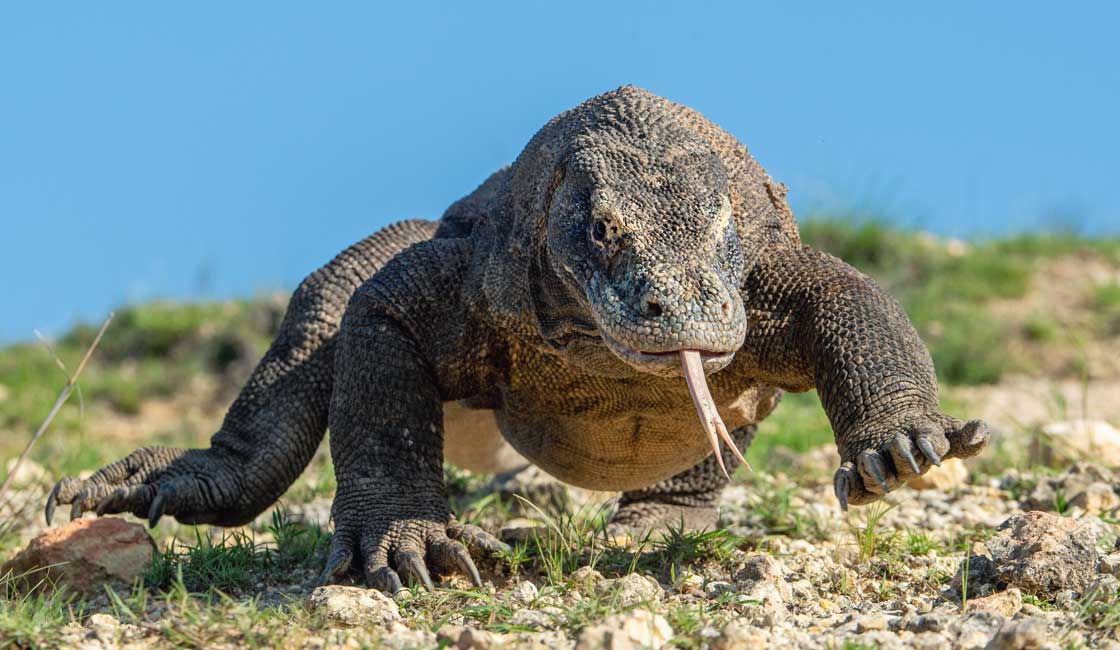
Komodo dragons are the absolute bosses of the lizard world. These creatures have been around for 900,000 years, sauntering around the Indonesian Islands with their long claws and thick reptilian tails. They are also known by natives of Komodo Island as ‘ora’ and ‘buaya darat’, meaning land crocodile.
Seeing Komodo Dragons in their natural habitat is one of the things to remember. The primal force of nature appearing before your eyes. It’s no surprise that the tours and cruises in Komodo National Park are gaining popularity by year, especially among photographers and nature lovers. Read on below to learn more about Komodo Dragon Facts.
The Komodo dragon was first discovered in 1910 when Dutch colonials were exploring the Indonesian Islands. Knowledge of these creatures became widespread some 2 years later after Peter Ouwens published photographs and skin samples extracted from the recently discovered creature. The first Komodo dragons to integrate into western culture arrived at the London Zoo for the Reptile House when it first opened its doors in 1927. Three of these original specimens are still in London to this day, (stuffed and preserved of course) at the National History Museum! The evolutionary origin of these lizards began in Asia roughly 40 million years ago; From Asia, these animals migrated to Australia where they increased in size into giant forms of their former selves. 15 million years ago a collision between Australia and Southeast Asia allowed the Komodo dragons to move yet again to another continent – here they found a home in what we now know as the Indonesian archipelago.

Wild and dangerous
Komodo dragons are extremely distinctive-looking creatures. At first glance, you will notice their textured and rough scaly skin – the bony plates that show on their armored surfaces are called osteoderms. Their general coloring can be a range of hues from glistening orange to sparkling blue, swamp green, and/or grey. Noticeable from the exterior, the Komodo dragon has sizeable claws and an enormous tail, which measures the same size as its body in length! Their long claws and strong forearms give them the ability to dig holes, which they then burrow into and use for sleeping. Conventionally these sensational animals weigh around 70 kg as fully grown adults. Nevertheless having said that, the largest recorded wild specimen was a female weighing in at 166 kg!
As for the interior, Komodo dragons have 60 serrated teeth – almost twice as many teeth as a human! These mini daggers are replaced regularly, encasing their long, yellow, deeply forked tongues. These unique specimens use their tongues very cleverly for tasting, detecting, and smelling stimuli just like other reptiles. Due to their vomeronasal senses, Komodo dragons can distinguish smells, and therefore prey, up to a huge 9.5 km away! Unfortunately, their eyesight is not as accomplished as they can only see clearly for up to 300 meters and struggle with identifying stationary objects. Ultimately, its least developed sense is actually hearing – these creatures have restricted hearing to a maximum of roughly 2000 hertz. However, Komodo dragons have been recorded to respond to sound signals, which proves these inquisitive lizards are not completely deaf.

Observe the Komodo Dragons in their natural habitat
These compelling creatures run around rapidly, shuffling their head from side to side as they do so. It’s no wonder how they have survived so long as these lizards thrive in almost every element – they can run at high speeds of up to 20 kmph, dive deeply down to 4.5 meters in water, and climb up trees and flora with their powerful limbs. Be that as it may, due to their immense weight they will struggle to climb very high without falling or giving up. Komodo dragons combat this by standing on their hind legs, using their tail as a supporting structure to create somewhat of a tripod, in order to balance and catch prey that would be otherwise out of reach. These crafty little reptiles prefer to reside in hot and dry places, typically dwelling about in the savanna, open grasslands, or tropical forests. Komodo dragons are rather solitary creatures, explicitly come together for hunting or mating – aside from these activities the lizards will remain completely unaccompanied and detached from social activity.
Hunting requires the utilization of a stealthy approach; Using their tails and tongues they will ambush their prey until finally, these carnivores can consume the carcass. Their innate sense of smell allows them to locate a successful hunt from far away, to which they will scuttle towards in hopes of a bountiful feed. Prey is devoured in a hierarchal procedure, with the largest to the smallest dragons getting their share. Sometimes there will be a little disagreement over who should be first, resulting in squabbles and fighting in the instance. Because of their slow metabolism, Komodo dragons can survive on as little as 12 big feeds in one year! And just like people might wipe their mouths after a hearty meal, Komodo dragons rub their faces into surrounding dirt or bushes after eating, insinuating they don’t massively enjoy the smell of the raw flesh they have just devoured. You don’t have to worry as they don’t attack or eat humans (usually)…
While Rainforest Cruises aim to provide accurate and up-to-date information, we make no representations as to the accuracy or completeness of any information herein or found by following any link on this site. Rainforest Cruises cannot and will not accept responsibility for any omissions or inaccuracies, or for any consequences arising therefrom, including any losses, injuries, or damages resulting from the display or use of this information.




